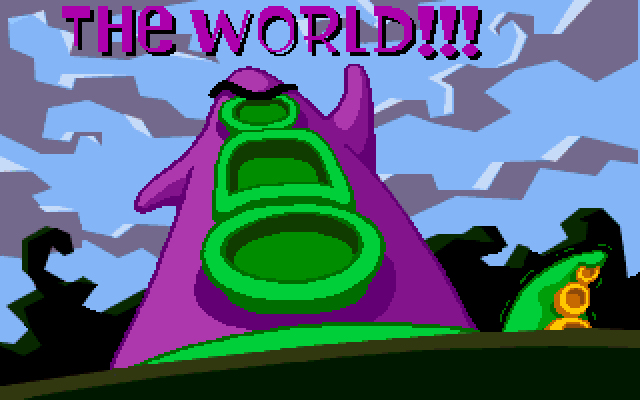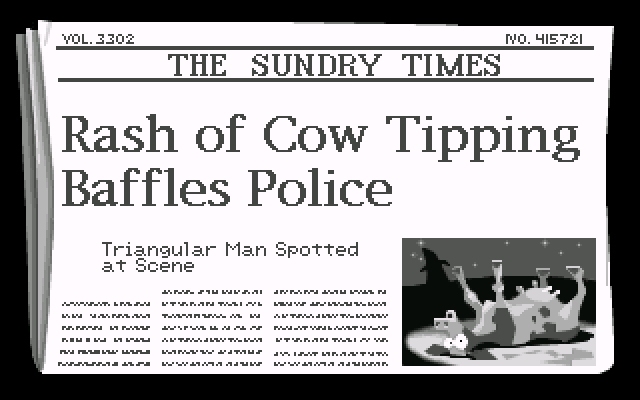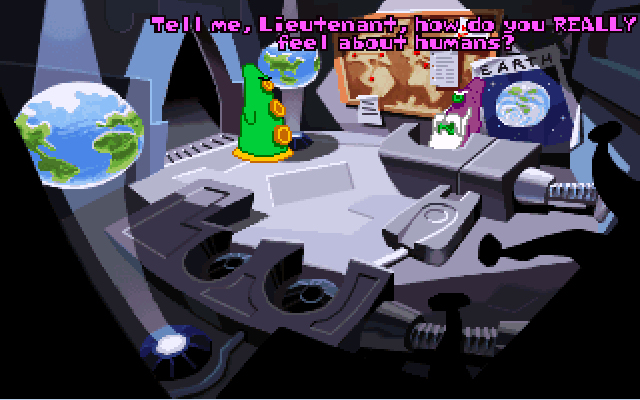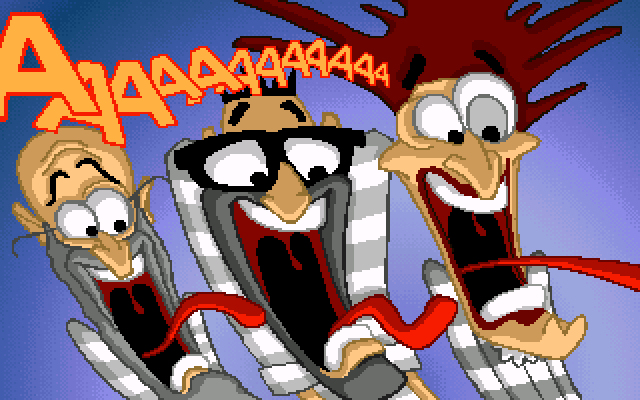Articles

LucasArts' Secret History #8: Day of the Tentacle Our Review
Sure, the whole is greater than the sum of its parts, but when it comes to classic adventure games sometimes there's one element that's so strong as to be defining. Some may cite the humor as the primary selling point of a game like Sam & Max Hit the Road, or the writing as Grim Fandango's, or the striking artwork as The Curse of Monkey Island's. Even when said feature is hardly the only attraction, it can't not be mentioned whenever the game is brought up. For how many games is that noteworthy feature its design? Even when a game is expertly architected, the average gamer, or even the critical reviewer, will not necessarily single this out; in theory, it's not supposed to draw particular attention to itself. But if any game merits special mention of its design the way others may of their graphics or story, Day of the Tentacle is it.

Coming off of Monkey Island 2, Dave Grossman and Tim Schafer were in the market for a new project. After their work as designers/writers/programmers on the first two entries of the cherished pirate series, they'd been elevated to the status of "project leaders," meaning that their next game would be the first on which they would be given the reigns. Both lovers of the even then-classic Maniac Mansion, the adventure game gods-to-be were given what Schafer has described as "kind of an idea for a sequel" that Ron Gilbert, Mansion co-conceiver, had in mind. With this rough basis, Grossman and Schafer collaborated to make what would become Day of the Tentacle (sometimes lengthened to Maniac Mansion 2: Day of the Tentacle or Maniac Mansion: Day of the Tentacle), released in 1993 in both floppy disk and speech-enabled CD-ROM versions.
One of the most interesting observations to be made about the final result of Grossman and Schafer's labors is its position as a sequel – it's a pretty loose one. Scratch the "pretty." This is a completely standalone game, self-contained to the point that many of the people who've played it have done so without knowing that it is a second installment. It was newcomers, and not devotees of the world's first SCUMM game, that Grossman and Schafer were striving to win over when constructing Tentacle, and the result is something accessible to everyone. This approach was sensible given the five year gap separating the two games, but that doesn't make the enormous creative success it yielded any less remarkable.
The main reason Day of the Tentacle is such a hairpin turn despite sharing a handful of elements with its predecessor is the fact that it draws from completely different inspirations. With Maniac Mansion, Ron Gilbert and Gary Winnick sought to tribute the horror/scifi B-movie genre. With Day of the Tentacle, that influence was replaced by the work of Chuck Jones. If Maniac Mansion is like playing through a cheesy horror movie, Day of the Tentacle is like playing through a Saturday morning cartoon, and everything from the brand of humor to the puzzle mentality reflects this. Knowledge of the previous game is not assumed, and there's definitely a "reboot" feel to the whole project - this game is in a completely different spirit than the original, sporting a new style and tone. Not that this change was an unwelcome one. In fact, that Day of the Tentacle is very much Maniac Mansion's equal in terms of quality is probably the mildest praise one will see bestowed on the game, which tends to be considered among the best LucasArts produced.
Day of the Tentacle begins with Green Tentacle and Purple Tentacle, the bizarre Edison family's homemade, mutated pets, coming upon a pair of drainage pipes outside of the house regurgitating toxic sludge (waste from Dr. Fred's secret laboratory) into the river. A parched Purple drinks the sludge, giving him a pair of arms and a personality bent on world domination. When Dr. Fred plans to kill both of the tentacles as a result of Purple's mutation, including the innocent and rock music loving Green, Weird Ed Edison's pet hamster sends for nerdy college student Bernard Bernoulli to intervene. Bernard and his two roommates Hoagie (a pudgy heavy metal roadie) and Laverne (a zoned out med student) head to the Edison mansion, which has since Bernard's last adventure there been renovated into a cheap motel, to free the tentacles found tied up in Dr. Fed's basement.

When Bernard succeeds, inadvertently allowing the evil Purple Tentacle to set out to take over the world, Dr. Fred sends the undergrad trio semi-voluntarily twenty-four hours into the past in his homemade time machine. The transports for each of the three travelers are "Chron-O-Johns" (essentially glorified outhouses) so that they can turn off the Sludge-O-Matic machine, thus preventing Purple from ever drinking the mutagen. Unfortunately, during their psychedelic journey through time the imitation diamond that powers the time machine shatters, causing each of the three kids to wind up in a time period different than the intended destination of Yesterday. Bernard simply returns to the present, but Hoagie winds up two hundred years in the past, and Laverne two hundred years in the future.
In order to get his friends home, Bernard must obtain a replacement diamond for the time machine while Hoagie and Laverne must find a way to plug in their respective Chron-O-Johns - a challenge for Hoagie since he is in colonial times, and for Laverne because she is in an era where tentacles have taken over the world and humans have become enslaved.
With a time-traveling premise and an even wackier tone, Grossman and Schafer took some of the cast and the basic gameplay conceit of the Maniac Mansion and went totally their own way with it, and it totally works. The notion of three playable kids who must think their way out of a "single" location by way of their individual abilities (in the original game represented by the characters' personal talents, and here by the different time periods that the characters occupy) has returned, with the team having to work together to achieve both shared and individual goals.
Other than that and the reprisal of a few of Maniac Mansion's faces (mainly the Edison family and side character turned leading man Bernard), there's little connection between this game and the original, and even the returning characters aren't all that true to their previous incarnations. Sure, Dr. Fred's benevolence can be explained away by the fact that he was under the influence of an evil meteor in the first game, but Nurse Edna's savage lust and the murderous inclination of Weird Ed and the tentacles all evaporate, or are at least heavily toned down, in the sequel's more morning cartoon spin on the universe. The layout of the mansion, modified into a cheap motel to make ends meet for the financially struggling household, is totally different, and the characters even reference the original game as a video game based on their lives five years ago, essentially placing Maniac Mansion in a different reality altogether.
Grossman and Schafer, serving both as the writers and designer, have a lot of fun simultaneously sending up and celebrating the time travel genre. The writing is superb, and although conversation trees (Hoagie's flag design suggestions to Betsy Ross and one-sided Ted banter are highlights) seem a bit more sparse, the dialog is always top notch, and the humor is sharp, poking fun at everything that invites mockery by appearing on screen. The different time periods allow our kooky main characters to interact with a rather eclectic bunch of inhabitants of the mansion, ranging from Edison ancestors (including the perpetually mummified Dead Cousin Ted) and the Founding Fathers (though not exactly as elementary school had us imagining them), to the present day Edisons and their sleazy motel's guests, and finally the futuristic tentacle overlords and their human pets. The exaggerated personalities of all of the above - Ben Franklin, for example, is depicted as a self-important buffoon who steals all his ideas - make for hilarious situations, and despite the endless potential of the game's zany premise one never gets the sense that opportunities were missed.

The story's use of three timelines also encourages constant interaction between the three playable characters, all of whom are running around in the same building hundreds of years apart. In the original game, the kids had a handful of very specific abilities and limitations but were otherwise only different in looks, and as such team work was often a case of convenience moreso than necessity. Here, however, with each character occupying a different version of the mansion with exclusive access to items needed by their friends, there is the constant need for inventory items to be traded (sometimes through more creative channels than the Chron-o-John) and occasionally for history to be rewritten, such as when Hoagie provides a perpetually agitated Betsy Ross with a national flag design that isn't quite the one we know of today. The puzzles that evolve from this high energy framework are funny, fun, and always clever. In fact, if there's any one word most apt to describe Day of the Tentacle, clever is the one I'd select.
That description extends to the remarkable puzzle design, which, in the opinion of this humble player, is the standard by which all other adventure games puzzles should be judged. Although coming out at a time when such a level of care for the player's sanity was not really in vogue (and I'm not sure we've ever left that time), Day of the Tentacle's puzzles tend to follow a line of logic (albeit a warped and cartoon-inspired one) that almost always makes a satisfying degree of sense. The worst thing that could ever be said of an adventure game puzzle once it's solved with the last ditch resort, the walkthrough, is something along the lines of, "Man, I could never have figured that out!" In a good adventure game, like Day of the Tentacle, the reaction is more along the lines of, "I can't believe I didn't think of that!" That's not to say that the game can't be difficult – it is, but the challenge lies in puzzles that are fair, creative and thought through.
But really, praising the puzzles as logical isn't giving them enough credit, even if that alone could be considered darned innovative. "Brilliant" might be a better start in the development of a truly appropriate description of the puzzle design on display here. Each solution doesn't just advance the story or unlock a new path, but provides satisfying sense of accomplishment and a punch line for a joke. The player's efforts are always paid off with something more than the bare minimum.
The game feels meticulously put together, and just how well the pieces fit can catch you off guard when solving a particularly multilayered puzzle. There's a craftsmanship at work here that overshadows the witty writing or the utterly charming presentation. Even while celebrating its fifteen year anniversary, Day of the Tentacle has a thing or two to teach modern adventure games, as well as any game that endeavors to incorporate puzzles that work in the story's favor rather than stand out as annoying distractions. And as complex as the game is, you're largely shielded from it thanks to clear, focused goals. For a game where just about every puzzle can be solved in any order, it somehow sidesteps the danger of being completely overwhelming.
The SCUMM interface used here is pretty much exactly the same as one featured in Monkey Island 2 and Fate of Atlantis, but DOTT does streamline things in simple but incredibly effective ways, such as by allowing inventory items to be selected as an applied cursor just by clicking on them. It's most useful when it comes to exchanging items between the playable characters, because they can simply be dropped onto a character's icon as a shortcut for the player needing to walk all the way back to the Chron-o-John. There's an acute awareness, and targeted elimination, of the little things that cause unnecessary time and work on the player's part. With DOTT, the already intuitive SCUMM interface continued to shed the extraneous.

The art style, like most other aspects of this game, is a huge departure from the original's take, but absolutely stunning and in fitting with the new direction. The lengthy gap between the two games and the leaps in technology made in the interim made it possible for DOTT to employ a more stylized approach to its characters and backgrounds, an accomplishment which artists Peter Chan, Larry Ahern and the rest of the skilled team carry out with flair and attention to the subtleties. The backgrounds have the kind of disproportionate, warped look one might expect from an irreverent animated series, and the game's consistently funny sight gags all follow in that tradition as well. The animation, often accompanied by sound effects right out of a cartoon, is easily the best LEC adventure games had to offer at the time of release, with the talents of the artists and the latest tech both on showcase. In short, the characters and backgrounds have more personality, expression, and detail than Maniac Mansion was allowed to, all adding up to a visual presentation that holds up remarkably.
The second "Talkie" LEC adventure game, Day of the Tentacle's voicework is splendid, and a marked improvement over the strong first attempt that was Indiana Jones and the Fate of Atlantis. Part of this is undoubtedly due to the fact that the game was planned to be voiced from the beginning, unlike Fate of Atlantis, and so the writers were able to pen their dialog knowing that they would eventually be coming out of actors' mouths. The performers, which include the brilliantly cast Richard Sanders of WKRP in Cincinnati fame in the role of Bernard, and LEC regulars Nick Jameson and Denny Delk, all do great jobs, and match their characters' personalities perfectly. Although there is a floppy version (in which only the opening sequenced is voiced), I can't imagine ever playing this game without the terrific voice acting. The iMUSE-enabled score, once again composed by the Holy Trinity of LEC musicians (McConnell, Land, and Bajakian), is as offbeat and humorous as the material, from the Bernard Hermann-esque opening credits theme to the tongue-in-cheek renditions of colonial ditties. The soundtrack is an asset and a perfect complement to the game's visuals.
Finally, the game contains what is surely one the great video game Easter eggs. Maniac Mansion comes included as a game within a game, playable on Weird Ed's computer. In addition to giving the package an incredibly value, it's just a plain great idea. (Note: Although in ScummVM it isn't possible to play Maniac Mansion from within DOTT, players can still run it through the emulator by locating the Maniac Mansion resource files.)

Even with the game as funny, charming, and engaging as it is, you'd think surely you'd be able to find a weak spot somewhere, but you'd be wrong. Stacked up against Monkey Island 2 and Fate of Atlantis, which were hardly shallow experiences, DOTT easily takes the cake as the most nonlinear LucasArts adventure game ever made. Adventure games don't normally lend themselves to this level of nonlinearity, because it tends to come at the expense of a reasonably cohesive narrative, but thanks to its conceit and ingenuity, DOTT succeeds gloriously.
I suppose a part of me that wouldn't have minded seeing a more faithful continuation of the style Maniac Mansion established, but the sequel earns the right to go its own way. Its completely fresh approach also makes the series the most ripe for further sequels, because it sets the precedent of basically no continuity. There's a scarcity of story-related baggage that a hypothetical third Maniac Mansion game would have to carry. It's wishful thinking to even consider that, as there's no reason to ever expect LucasArts to revisit the series, but if they had the inclination, there's really no limit to what they could do.
Day of the Tentacle is one of those games that always seems to occupy a place near the peak of Top Ten lists (though, to be fair, so do many LEC adventure games), and it's really not hard to see why. All the trademarks of the best LEC adventures – humor, originality, fantastic artwork, extreme polish – are present here. It's a game that perfectly represents the Golden Era of LucasArts, both because it was released at a time when the company's frequency of output in the genre was at its peak, and because the quality of the game didn't lend itself very well to being surpassed. Objectively speaking, Day of the Tentacle is as good as any game the company put out, and I cannot think of a better example to demonstrate the lofty heights a superb adventure game can reach.
By Jason, who subscribes to Bernard's theory about pushing old ladies down the stairs.
Five out of five Murray skulls
Pros: Standard-setting adventure game with clever and fun puzzle design. Story, dialog, characters, art, and soundtrack all come together in a rather perfect package. As close to flawless as an adventure game has ever come.
Cons: I thought Ted was Edna's cousin in the original game. How's he still around in colonial times?!